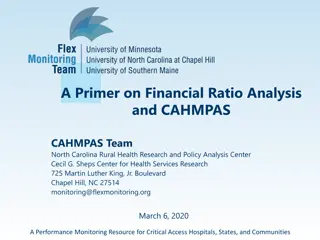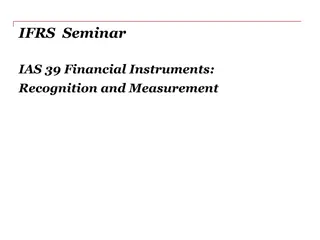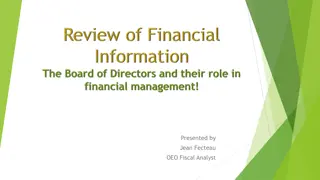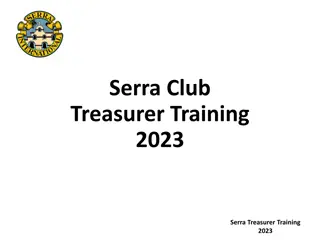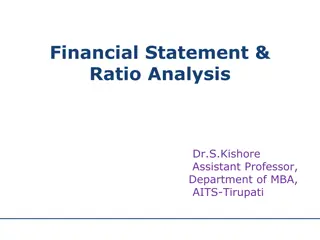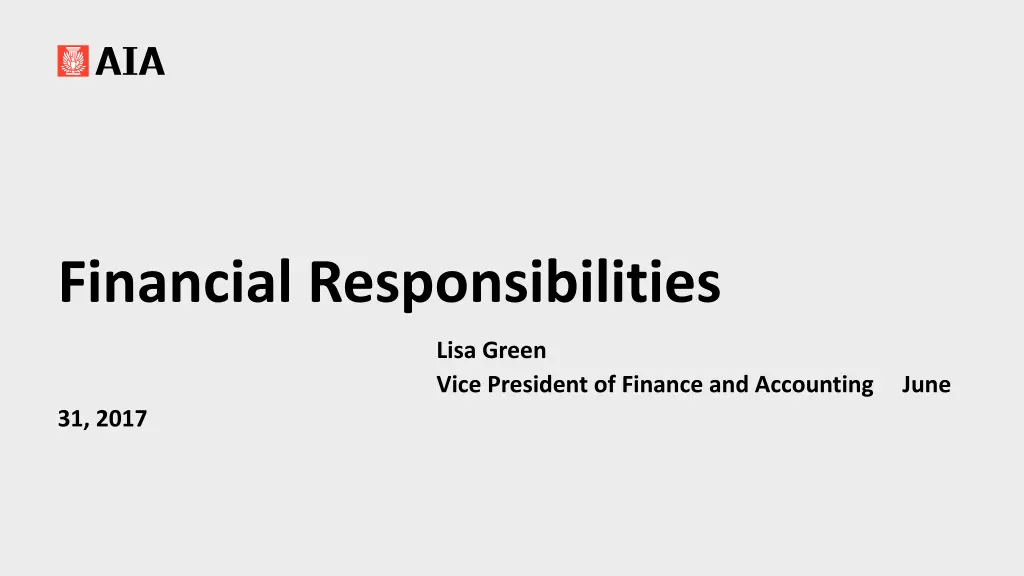
Financial Responsibilities and Internal Control for Business Operations
Learn about financial responsibilities including managing financial records, implementing internal controls to prevent errors and fraud, and the importance of business insurance and record retention in safeguarding the organization's financial interests.
Uploaded on | 0 Views
Download Presentation

Please find below an Image/Link to download the presentation.
The content on the website is provided AS IS for your information and personal use only. It may not be sold, licensed, or shared on other websites without obtaining consent from the author. If you encounter any issues during the download, it is possible that the publisher has removed the file from their server.
You are allowed to download the files provided on this website for personal or commercial use, subject to the condition that they are used lawfully. All files are the property of their respective owners.
The content on the website is provided AS IS for your information and personal use only. It may not be sold, licensed, or shared on other websites without obtaining consent from the author.
E N D
Presentation Transcript
Financial Responsibilities Lisa Green Vice President of Finance and Accounting June 31, 2017
Financial Records Smaller Component Checking Account Only All receipts deposited Approved disbursements withdrawn Surplus funds invested Larger Components More elaborate systems Financial Statements
Internal Control Assures that financial errors are prevented or detected quickly Helps to mitigate fraud risk. Add fraud protection to banking services (positive payee, ACH Monitor). Ensure those who are accepting credit card payments are PCI Compliant. Keep financial records and personal information secure. Personnel: bonded for protection, supervised to prevent errors Standardized authorization and recording of transactions continue
Internal Control continue Segregation of functions: record keeping, check signing, disbursement authorization and depositing funds: Mail opened by someone other than person handling cash receipts Person responsible for cash receipts other than cash deposits Approval of vendor invoices by responsible person All disbursements made by check or electronic payment. Verify payment requests! Checks signed by other than A/P preparer. Require W-9s for vendors. Payroll checks signed by other that payroll preparer Bank statement reconciled vs. signing checks or cash receipts
Financial Statements Balance Sheet Statement of income and expenses Cash Flow Supplemental financial statements Analysis of investments Variance reports
Business Insurance Protects the organization against economic loss Basic of insurance: Fidelity insurance against loss from dishonesty Comprehensive general liability insures against damages to persons or property Fire insurance insures from fire, smoke, water, damage Directors and Officers insures against personal damages to the organization s Directors as a result of their actions Others (professional liability, Cyber Security, etc)
Record Retention Permanent - IRS exemption application, determination letter, corporate charter, bylaws, contracts, deeds, leases Lifetime - Employee benefits records Lifetime - Grant and endowment records 7 Years - Bank and investment records 7 Years + - Federal 990 and other returns Three most recent 990s must be open to public inspection 6 Years - State and local tax filings 6 Years - Financial records
Budgeting & Reporting Why Budget? Budget provides planning tool Helps to prioritize needs and allocate resources Defines management goals Provides benchmark to evaluate future performance Reporting and Independent Auditors Should report financial information to Board to ensure transparency and oversight Books should be reviewed or audited to assure Board of accuracy of financial records
Nonprofit Tax Issues What are a Component s tax responsibilities? Adhere to exempt purpose trade associations - 501(c)(6) Taxable activities are permitted, but keep them small Be accountable to members File all required returns and reports (Federal and state) Form 990 (and 990-T, if required if UBI present) State tax return (if required) Other state filings: registration, escheat, property taxes, sales & use. Keep good books and records Don t engage in prohibited activities Disclose lobbying percentages on invoice
Criteria for Tax-Exempt Status No part of net earnings benefit one member Association of persons with common business interests Purpose to promote the common business interests Not engaged regularly in business unrelated to purpose Activities not confined to services for particular members
Nonprofit Tax Returns Federal Form 990 Must be filed by ALL exempt organizations. Due 5-1/2 months after end of fiscal year; Two 3-month extensions are permitted (filing deadline after extensions is Nov. 15) Form 990-N Postcard return if gross receipts are <$50,000 Form 990-EZ may be filed if gross receipts are <$200,000 and end-of-year assets are <$500,000 Form 990-T must be filed if gross unrelated business income (UBI) is more than $1,000 Don t forget to file 990 s for related foundations, if the gross receipts test is met Many states also have a tax return that needs filing, especially for unrelated business income.
Nonprofit Tax Returns continue Other Taxes and Filings Sales and use taxes Associations can t get an exemption Must collect and remit on products sold and sometimes other things. Must pay sales tax to vendors on required items. State registrations (mainly for charities only) Real and personal property taxes Payroll taxes Unemployment taxes
Unrelated Business Income Trade or business, regularly carried on, not related to exempt purpose. Does not include certain passive revenue streams: interest income, royalties, most rents, dividends, capital gains, conventions. Typical UBI activities of associations and their chapters: Advertising: call to action, quality, comparability Magazine, newsletter, Web banners, job classifieds, online job banks Online member directories, if similar to an ad Mailing Lists Affinity programs, if association provides services Rental of building to outside groups
Lobbying Expense Trade associations may lobby, but lobbying expenses are not deductible. This rule applies to Federal and state lobbying efforts. Associations either pay a proxy tax or pass on nondeductible costs to members Proxy tax is 35% of lobbying expenditures Costs are passed on to members via a notice on dues invoice Calculating lobbying expenses isn t difficult, but lobbying communication rules are complex.






